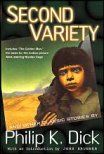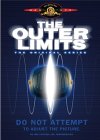
Naturally, any theory of time travel is just that: a theory. For the purposes of this FAQ, the best we can do is try to apply one or more of these theories, while still maintaining internal consistency with the info presented in the films. There are many theories of time travel in science fiction and comics. However, most discussions of time travel focus on two theories of "real-world" physics: classic Newtonian and quantum mechanical physics. For a good introduction to the application of these theories to time travel, see the article, "The quantum physics of time travel" in the March, 1994 issue of Scientific American.
The classical theory states that there is one existence, and thus a single timeline. According to this view, changing an event in the past could theoretically retroactively change history from the time traveler's POV. This theory is plagued by problems of "temporal paradoxes". For example, what happens if you go back in time and prevent your parents from meeting? (According to the movie Back to the Future, you will "fade from existence!")
The quantum view is that time travel is possible along distortions in space-time called closed timelike curves; also, reality exists as a multiverse of infinite possibilities. Thus, if you travel back in time and prevent your parents from meeting, there's no paradox. Your parents still meet and conceive you in the timeline you came from (after all, you must have come from somewhere!). However, a "version" of you will not be born in the timeline you traveled to.
1995 2029
-----|----------------|--(existence with nuclear war) (A)
\_______________|__(alternate peaceful existence) (B)
So there you have it: good physics and a watered-down story, or a ream of paradoxes and a strong story.
Of course, everyone wants to know if time travel is possible, so let's go to NASA and a real physicist:
Q: What would have to be done in order to make time travel possible?
A: The first answer I thought of is that the laws of physics would have to
change. Now this does not necessarily mean that the universe would have to
change. Our understanding of the universe, and the laws of physics that we
use, are certainly imperfect. And general relativity does seem to allow some
paths through space-time that may indicate a possibility for time travel, but
these are way beyond our ability to test (for example, orbiting a
multi-light-year long, supermassive rotating cylinder). So at the moment,
there is certainly no known way for time travel.
-- Dr. Eric Christian (from NASA's Cosmicopia).
 |
David Toomey's 2007 nonfiction book The New Time Travelers is about the possibility of time travel, given our current understanding of physics. From the publisher's website: "Since H. G. Wells' 1895 classic The Time Machine, readers of science fiction have puzzled over the paradoxes of time travel. What would happen if a time traveler tried to change history? Would some force or law of nature prevent him? Or would his action produce a "new" history, branching away from the original? "In the last decade of the twentieth century, a group of theoretical physicists at the California Institute of Technology undertook a serious investigation of the possibility of pastward time travel, inspiring a serious and sustained study that engaged more than thirty physicists working at universities and institutes around the world. "Many of the figures involved are familiar: Einstein, Stephen Hawking, and Kip Thorne; others are names known mostly to physicists. These are the new time travelers, and this is the story of their work--a profoundly human endeavor marked by advances, retreats, and no small share of surprises. It is a fantastic journey to the frontiers of physics." |
The Terminator was able to go through time because it was surrounded by living tissue. The T-1000 could imitate living tissue, but it is made up of alloy metals, so it is not technically a biological organism, but neither was the Terminator.
Some possibilities:
Regarding the destruction of the time machine, Reese would have been gone before the machine was destroyed anyway. He wouldn't know for certain whether it was destroyed or not.
According to the classical, single timeline/universe view, it is impossible--unless Cyberdyne Systems develops Skynet technology independently of any help from the future.
Assuming the existence of a multiverse of timelines, this situation can also be explained. In the universe in which we see the Terminator technology destroyed, Skynet will never exist. However, there must exist at least one timeline/universe in which Skynet technology is developed. This may occur due to: a) Cyberdyne independently creating the technology, or b) Terminator remains originating from yet another timeline are left behind. Thus, the movies must chronicle two different universes: one with the hellish future dominated by Skynet, the other is the one saved by Sarah and John.
The preference by the filmmakers, however, is for a single timeline, as shown in T3.
According to classical physics, we have a classic paradox. No one wrote it, everybody just memorized it. Assuming a multiverse, on the other hand, we can posit that a future John Connor (whose mother encountered a Reese who perhaps forgot the speech) did write the speech, and gave it to Reese. Reese traveled back to 1984 in another universe, and gave it to Sarah (which we saw in T1).
 |
 |
Robert A. Heinlein's 1959 short story "All You Zombies--" (found in The Unpleasant Profession of Jonathan Hoag) is widely considered to be the definitive time-travel story. This story involves a number of paradoxes caused by time travel. These themes were developed earlier by Heinlein in his 1941 short story "By His Bootstraps," (in Adventures in Time and Space) written under the pen name of Anson MacDonald. |
 |
The 1973 novel The Man Who Folded Himself by David Gerrold was mentioned by quite a few people (Phineas <phin@west.darkside.com> described it as "quite a trip.") A character in the book inherts a belt that allows him to travel in time, which creates a number of paradoxes, which are resolved by multiple universes. It is similar to (but more complex than) Heinlein's "All You Zombies--." It was nominated for a Nebula Award in 1973, and for a Hugo Award 1974. |
 |
Larry Niven's 1968 short story "All the Myriad Ways," nominated for a 1969 Hugo Award, in a collection also called All the Myriad Ways, first published in 1971) explores the every-change-in-history-creates-an-alternate-universe idea. The story is based on the idea that there are an infinite number of these universes, branching off at every decision anyone ever makes. It's an interesting extension of just how irrelavant everything becomes in an alternate-universe-based view of things.
In that same collection is the essay, "The Theory and Practice of Time Travel." In this piece, Niven proposed that time travel revises history a certain number of times. The final revision creates a universe in which time travel is never discovered. Therefore, no paradoxes occur, and no resolutions are needed. |
Jeff Hart <jeffhart@erols.com> noted that Philip K. Dick's short story "Jon's World" from The Collected Stories of Philip K. Dick, Volume 2: We Can Remember it for You Wholesale has strong correlations with T2:
 |
Originally published in 1952, the short story is based on a leader of a human force fighting for survival in world destroyed after a battle against the 'claws' described as "complex robots that had been created as a war weapon. The claws had turned on their makers, designing their own new types and equipment."
Also featured is a favorite PKD plot line - an alternate reality. In this case, the character Jon has visions of a world that has not been destroyed by war. His father Ryan goes back in time to recover the papers used to create the original claws (intention is to recreate new claws that can be used to help reclaim the planet) & ends up accidentally killing the scientist responsible for the basic research. When Ryan returns to his time, he finds Jon's World - a world without the destruction. |
 |
First published in 1953, Philip K. Dick's short story "Second Variety" features a post-apocalyptic world in which enemy robots wear rubber skin to pose as humans (as mentioned by Reese in T1). A Canadian film based on the story, titled Screamers, was made in 1995, starring Peter Weller. |
(Incidentially, Philip K. Dick's story "We Can Remember it for You Wholesale" is the basis of another Arnold film, Total Recall.)
 |
Isaac Asimov's 1955 novel The End of Eternity is a mystery/thriller including elements of time travel and social engineering. |
 |
Stephen Baxter's 1995 novel The Time Ships is notable because it is an authorized sequel to the seminal time-travel story, H.G. Wells's The Time Machine. |
 |
Time Travel: A Writer's Guide to the Real Science of Plausible Time Travel by Paul J. Nahin was published in 1997. Amazon.com calls it "a tasty blend of quantum theory, worm holes, causal loops, and the famous 'grandfather paradox.'" |
Inspiration for the Terminator films can also be found in some early The Outer Limits episodes. These shows are available on VHS video and DVD.
 (VHS) |
 (DVD) |
The Outer Limits (Season 1, 1963) "The Man Who Was Never Born" (writer: Anthony Lawrence, director: Leonard Horn).
A horribly mutated man from the future (played by Martin Landau) returns to the present to try kill the man who created the biological disaster that led to the desolate future Earth. |
 (VHS) |
 (DVD) |
The Outer Limits (Season 2, 1964) "Soldier" (writer: Harlan Ellison, director: Gred Oswald)
Somewhere is Earth's distant future: on a blasted, radioactive no-man's-land, two soldiers battle in a crossfire of death beams, and a bizarre time-warp is created. Wrenched out of the future, flung back in time to today, Qarlo (played by Michael Ansara) is a killing machine without a war. |
 (VHS) |
 (DVD) |
The Outer Limits (Season 2, 1964) "Demon with a Glass Hand" (writer: Harlan Ellison, director: Byron Haskin)
When the future Earth is conquered by an alien race, a lone survivor--an intent, enigmatic man named Trent (played by Robert Culp)--finds himself thrown back a thousand years into our present. Trapped in a delapidated office building, he holds the fate of mankind in his hand--a mysterious, incomplete glass hand that is both computer and oracle. |
 To previous section | To next section
To previous section | To next section 